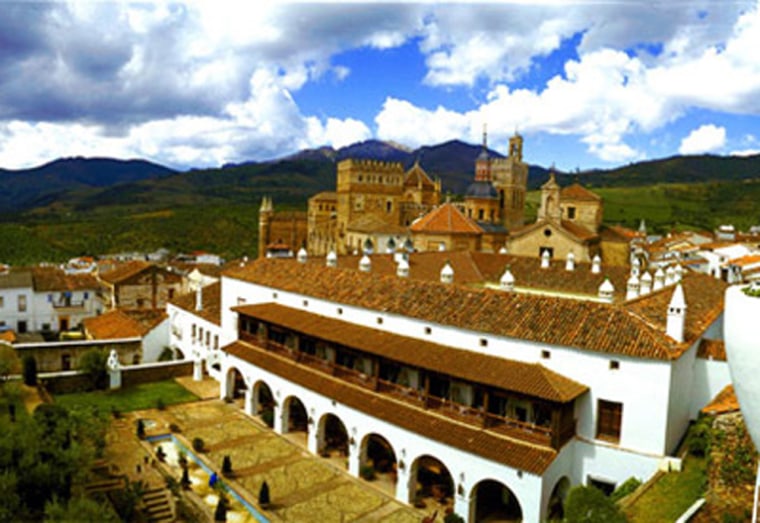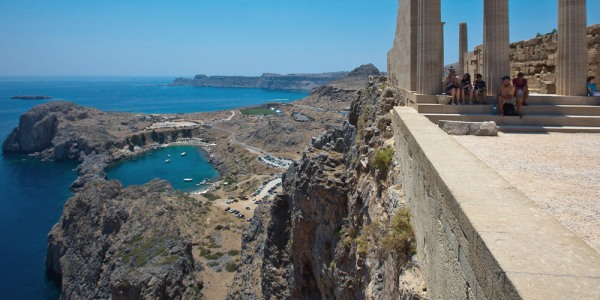Like any self-respecting 16th-century nunnery, the Convent of San Pablo in Cuenca, 100 miles southeast of Madrid, is remote and difficult to reach. From the bottom of the deep Hoz del Heucar gorge, a mountain road zigzags up a steep canyon, crammed with switchbacks and pine trees and ending at the convent’s tall stone walls and austere facade.
Inside, you’ll never believe that nuns had it so good: below the Moorish arches and authentic ceiling woodwork you'll find satellite TVs and minibars in each of the 62 rooms, a fine restaurant (inside the old chapel), a gym and a sauna. There’s even a swimming pool out back.
But Cuenca isn’t just any city — it’s a UNESCO World Heritage site. And San Pablo isn’t just any convent: It’s a historic parador, a “stopping place.” These days, it’s also a luxury hotel.
Spain has hundreds of important medieval buildings that still stand, some dating back to the Dark Ages. And monasteries, of course — along with cathedrals and palaces — are some of the most important. They occupied a rarefied status in small medieval towns, and despite modernization and growth, they maintain their lock on their area’s most beautiful locations.
However, after a few centuries of neglect, the monasteries and nunneries were simply disintegrating. So in 1928, the government started a national program to preserve the buildings while simultaneously generating cash for their upkeep by converting them into first-class hotels. It was no easy task: not only were the structures crumbling, but they lacked modern plumbing, heating, and electricity (not to mention central air, saunas, and Jacuzzis).
But the project paid off. It used to be that if you wanted to sleep inside a monastery you had one choice: take the vows and don the robes. Today all it takes is a credit card. The official directory lists 91 paradores, with 11 more on the way. There are paradores perched on the edge of ocean cliffs, paradores with golf courses, paradores in city centers. And staying in the Parador de Granada is the only way to remain inside the famed Alhambra after the outer gates close to the public.
And the experience of staying inside a slice of history is only getting better — five years ago, Spain launched a $496 million re-renovation program expected to be finished by 2011. But it’s not always five-star luxury. “Basically most of the renovations just seek to preserve the structure,” said Antonio Alonso, a spokesperson for the Office of Paradores in Madrid. Staying in a parador may be a very authentic experience, but it can also sometimes be a tad too monastic — you can’t always count on, say, luxurious bathrooms.

More luxurious paradores are sometimes — though not always — places were workers have had to gut the interiors and build bigger rooms touches like air-conditioning. But when major changes go in, said Alonso, they try to be subtle. The swimming pool of the Parador de Trujillo, a 16th-century convent, is hidden away on the rooftop.
Yet despite adding restaurants and swimming pools, paradores cling to their relaxing, monastic charm. They tend to be out-of-the-way — cloistered, you might say — and cozy. Monforte de Lemos, a hilltop monastery overlooking the town’s red roofs in the northwest region of Galicia, has only 50 rooms, and it’s one of the larger ones.
But once in a while you’ll find a parador as grand as a classic opera house. The elegant 226-room Parador de Leon in Spain’s Basque region is just such a place — a 16th-century Renaissance structure with magnificent cloisters overlooking gardens and a 300-foot facade with carvings depicting religious and historical events. On her hiking tour through Basque country, Catherine Merolle, a magazine production director in New York, stayed here. “With all the tapestries and paintings, and the wonderful architecture, I felt surrounded by history, luxury and peace,” she said.
Slideshow 23 photos
A European tour
Still, staying at a parador is not all about Gregorian chants and quiet reflection (though at Parador de Santo Estevo, near the Portuguese border, you can meditate on sangria at the bar inside the cloister). At the Parador de Chinchon, southeast of Madrid, things can get rowdy: the plaza faces the Plaza Grand and on summer Saturdays is used for bullfighting.
But even with the noise, the charm of the paradores is obvious. “Paradores are the exact opposite of these new hotels in Dubai,” said Merolle. “They’re very charming, and the ambience is very authentic. That’s what I go to Spain for.”

